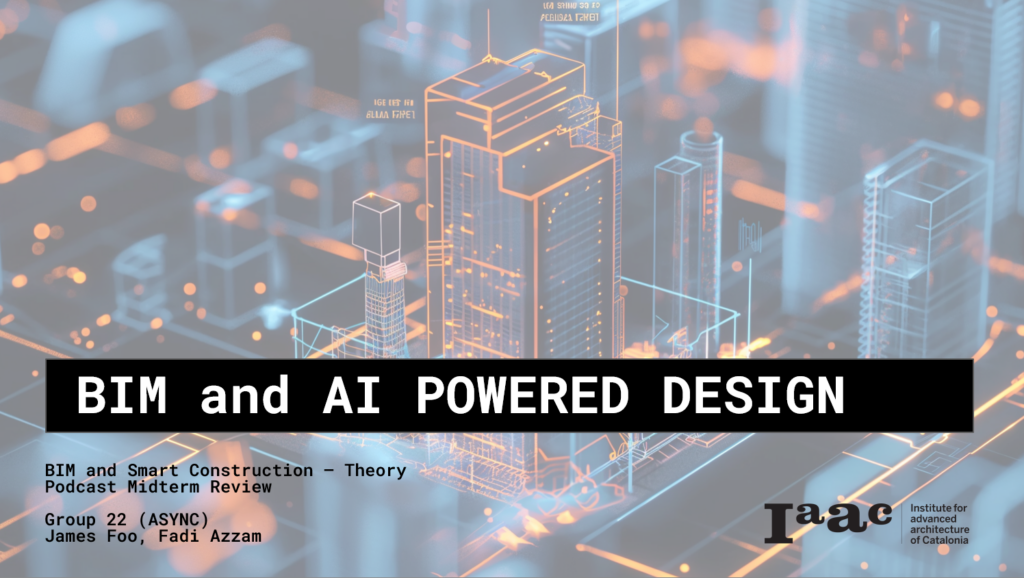Abstract

Artificial Intelligence is revolutionizing global industries, with the AEC sector being no exception. This study embarks on a comprehensive examination of AI’s role within Building Information Modeling (BIM) workflows, exploring its implications and envisioning the industry’s future post-AI integration.
Initial Research
Among the available AI aided BIM tools, we looked at the commonly used software in AEC and the tasks that they undertake within the design process, to establish the current state of development and to find the existing gaps in the process. Among these tools are: generative design and automation (Hypar, Autodesk), documentation management (PlanGrid Autodesk), model checking and clash detection (Solibri), code compliance review, Construction management (Procore), collaboration and data management (Trimble Connect).
Our initial findings is that the following limitations of AI BIM tools and gaps in the design process still exist:
- The common AI tools available are either too conceptual with little technical merit to allow it be incorporated in process in a productive manner, or too systematic processing predetermined data or data that has been produced by humans.
- AI tools are designed to tackle specific tasks in isolation from the full AEC process, and have limited interoperability between different software.
- AI aided tool have very limited presence in certain design stages such as schematic design which is one of the most demanding stages in terms of input from multiple disciplines, coordination, and human expertise.
This lead us to choosing our expert from SKEMA.AI who are developing an AI tool that target schematic design stage. Our aim was to gain an insight on the inner workings of their AI tool at this demanding design stage, and to understand the challenges that this tool faces, and how applicable these challenges are to other stages of the design process. These insights would help us assess the current reliance on the human factor, and speculate the future development AI tools in BIM and the AEC industry.
Expert
For our podcast, we interviewed Marty Rozmanith, co-founder and chief technology officer of SKEMA; a new BIM software which uses a catalogue of parts derived from an architecture firm’s existing BIM library to generate a detailed BIM model from basic basic massing input. Marty is a 30 year veteran in the world of AEC software development. He was part of the original Revit development team before it was even acquired by Autodesk and also helped write the requirement specifications for what would eventually become IFC. Additionally, he has published works in The Wall Street Journal and Forbes discussing modular design and digital twins in the AEC industry. As a pioneer of both BIM and AI in the AEC industry, Marty provided exceptional knowledge and insight on both subjects.

Findings
Procedural Algorithms vs AI
One of the first subjects discussed on the podcast was defining what AI is and how to differentiate it from procedural algorithms. Procedural algorithms can take data and perform specific operations to it, allowing for the results to be predictable. In contrast, AI takes input data and output data and attempts to find a pattern between the two. There are even times where there will be no pattern yet the AI still gives a result as if a pattern existed. These are called hallucinations and can make AI harder to work with and control.
AI – Accessibility and Liability
A key aspect of our investigation into AI and BIM was the fact that AI tools are making the design process increasingly accessible to people, including those without training. Our specific interest lied in the idea that one day AI software will allow clients and developers to bypass the architect. Marty actually has an investor in Skema who was interested in how it could be used to conceptualize a project using the software. However, while the tools could help generate the design, and architect would eventually have to be brought on to the project. This is due to the fact that the architect has the legal liability regarding life safety, fire, and a plethora of other codes, all of which vary by region. Marty said that the giving developers and owners access to the design process may even generate a pipeline of work for architects since they would eventually need to be brought into the process.
Business Models and Quality
The current architecture business model for architecture in the US revolves around billable hours for pricing architectural services. However, AI tools such as SKEMA are beginning to shorten the number of hours required to finish a project, ultimately cutting into a firms revenue stream. As AI becomes more standard in professional practice, the architecture business model will need to adapt to stay profitable. According the Marty, this will most likely result in a focus on quality, as the time saved by using AI tools will allows architects to spend more time during the conceptual phase of the project.
AI and Digital Twins
Currently, architects and their consultants do not create high accurate BIM models simply due to the immense time and effort required to implement details necessary. However, with AI reducing the time needed to both find the data and create the model, higher quality BIM models could be produced. This could eventually lead to a higher adoption of BIM models for building management through the use of a digital twin, allowing for more efficient buildings and building management.
Conclusion
In short, the human factor and expertise will remain relevant, if not more relevant, with the development of AI in the AEC industry for the following reasons:
AI will continue to be highly input dependent. The amount of data, the applicability and the quality of this data are key to generating successful output.
AEC industry have low tolerance for unpredictability in the design outcomes, this is why even the most generative design tools have a relatively small percentage of true AI in there makeup. Successful tools rely the most on procedural computation for producing results.
Linking AI tools between different disciplines is still a challenge that is yet to be overcome. This can be achieved by incorporating more data into the system, which further proves the reliance of this system on expert human input.
Other factors include the legality of handing over crucial tasks in this heavily regulated field to a non-human entity which is incapable of taking liabilities or legal obligations. Resolving this can prove more challenging than the technical factors.
Nevertheless, AI tools have proven to be essential in aiding the design process, especially when they are used to compliment rather than replace human expertise. They have been heavily implemented by leading AEC practices to remain competitive, and they will continue to be valuable to architects and engineers, provided that they know how, where and when to best utilize these tools.
Links:

